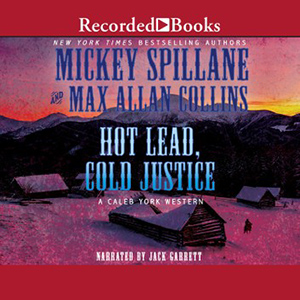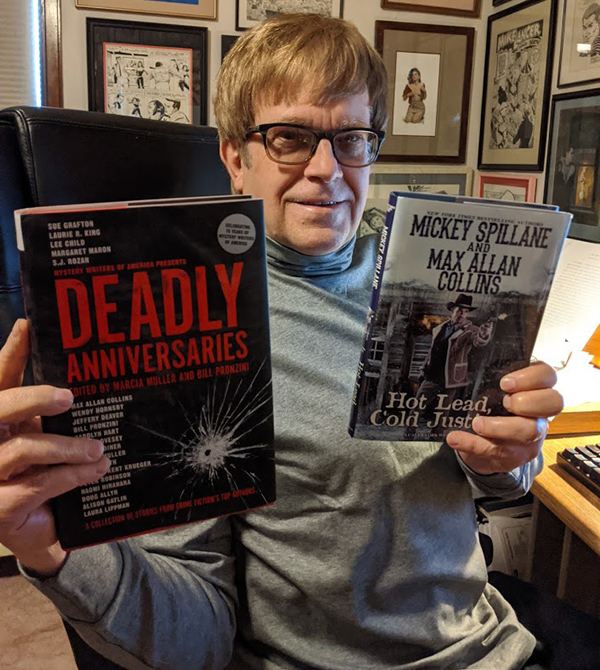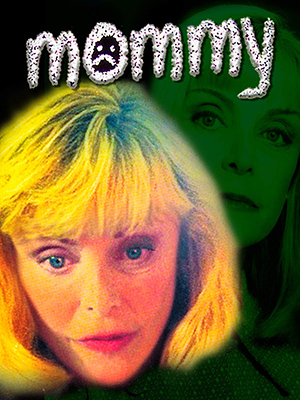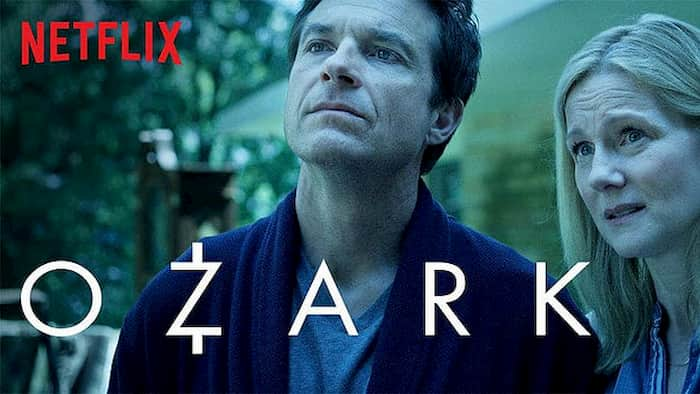The day this update appears (May 26) is the pub date for the new Caleb York western novel, Hot Lead, Cold Justice.
Unlike the other Spillane co-bylined books in the Mike Hammer series (and other crime novels), these westerns are mostly by me, working with characters and situations from Mickey’s various drafts of his screenplay, The Saga of Calli York, written for John Wayne but never produced. I have endeavored in these novels – I just completed another – to bring either a strong mystery or crime novel element into the proceedings. Even if you don’t usually read westerns, I think you will have a good time – assuming you are reading my other work, in particular the Spillane material.
I am not a voluminous reader of westerns myself, though I have long been a fan of western films. I can talk John Wayne, Randolph Scott, Joel McCrea and Audie Murphy with the best of ‘em; same goes for directors like Sam Peckinpah, Budd Boeticher, Anthony Mann, John Ford and Howard Hawks. The early seasons of Maverick are mid-century TV at its best. Probably my favorite western novel (and there’s a certain irony about this – see if you can catch it) is the novelization of Howard Hawks’ movie Rio Bravo by its screenwriter, Leigh Brackett, the woman who shared screenplay credit with William Faulkner on the same director’s film of The Big Sleep.
I’ve never been a big Faulkner fan, but there are two stories about him that I love.
One is that a frustrated reader told him how much trouble he was having understanding what Faulkner had written in The Sound and the Fury. Faulkner told him, “Have you tried reading it drunk? That’s how I wrote the thing.”
Another is that Faulkner was paid big money to fly to a college campus to talk to a creative writing seminar as their keynote speaker. When his turn came, Faulkner went to the dias and asked how many of the college students wanted to be writers. They all raised their hands. Then Faulkner said, “Then why the hell aren’t you home writing?” And sat back down.
I don’t know if either of those stories are true, and I don’t care. Somebody already mentioned here once said, “Print the legend,” and I agree with that.
Getting back to Hot Lead, Cold Justice – a title I suggested as a joke that was immediately embraced (mine was The Big Die-up) – a lovely review has appeared at that great book review site, Bookgasm, and rather than put you to the trouble of chasing a link, here it is (written by Mark Rose):
For those who don’t know, Spillane and Collins were friends, and upon the former’s death, he entrusted his literary property such as his characters (Mike Hammer) and unpublished screenplays (where the character Caleb York originated) to Collins. So Collins has written a number of Mike Hammer stories and now explores the world of late 19th-century New Mexico.
It’s a tough frontier world but the little oasis of Trinidad, New Mexico seems just fine for Sheriff Caleb York. Until his deputy is shot twice and left to die. York had just given the man his long coat and hat, and he’s convinced that the gunmen were aiming for York and not the deputy. Luckily, the deputy survives. But York knows he’s got men after him now.
These men are a rough and brutal lot. Their leader rode with Quantrill, the notorious Missouri raider who massacred the men in the free state town of Lawrence, Kansas during the Civil War. They’ll stop at nothing as they attempt to rob banks in the area in order to set up a stake for themselves and eventually go live on a beach in Mexico. And while they do that, they can find time to ambush York and bring his do-gooder life to an end.
This is a short (just over 200 pages), rip-roaring read with the fast pacing and smooth style that characterizes all of Collins’ work. Characters are simply described, but set up with credible backstories and behaviors. The scenery is all well-described. Dialogue is spot-on, except perhaps for the unfortunate dialect awarded to the deputy’s voice.
If you want a movie-style Western and you’ve read all your Louis L’Amours, I think it would be a place to start with Max Allan Collins and Mickey Spillane’s books featuring Caleb York. Here are the titles in order:
The Legend of Caleb York, The Big Showdown, The Bloody Spur, Last Stage to Hell Junction, and Hot Lead, Cold Justice.Wow. That’s an overwhelmingly positive review, huh? But of course that doesn’t stop me from having a bone to pick.
Well, not really. I get it – I understand how somebody entering the serious, relatively realistic world of Caleb York could have difficulty with Deputy Jonathan P. Tulley’s “dialect.” But the thing is, Tulley isn’t speaking a dialect at all. Nobody ever spoke like that. I have no idea where I’m pulling that patois out of, unless I’m sitting on it.
We are in the territory of a character who is great fun to write because he can say or do just about anything, and I don’t have to apologize (even though I seem to be right now.)
Tulley has much in common with Mother (aka Vivian Borne) in the Antiques novels, because there doesn’t seem to be any behavior or train of thought or speech that she can’t get away with. Whenever I think I’ve gone too far with Mother, I run it past Barb and she always says the same thing, “There’s no way you can go too far with Mother.”
That’s because, at least in part, Vivian Borne was conceived as the comedy relief – the sidekick to her amateur sleuth daughter, Brandy. The problem is that Vivian (not surprisingly) didn’t behave. She insisted on having equal footing with Brandy, and began pushing for first-person chapters of her own. She has also developed into a hell of a detective, or (as we say in the cozy world) a heck of a detective. For a long time the girls argued over who was Holmes and who was Watson. But, really, it didn’t take long for Brandy to realize she was Archie Goodwin to Mother’s Nero Wolfe – only Mother is not at all a stay at home detective.
By the way, Antiques Fire Sale was published just a month ago, and is a good place to see what it is I’m talking about.
Sidekicks often become more popular than the more recognizably human heroes they hang around with. Does anyone really think Roy Rogers, for all his charm and his lovely singing voice, was more memorable than Gabby Hayes? What was Marshal Dillon without Chester? When Dennis Weaver left his Good name behind to be a full-fledged hero himself, Festus had to be called in off the bench.
It’s the Kirk and Spock effect.
As for that pesky dialect of Tulley’s, I have written him in a long tradition of characters like Dick Tracy cast members B.O. Plenty and Vitamin Flintheart. No hillbilly ever spoke like B.O., but that didn’t stop Chester Gould from letting him talk, or me from letting him devolve into a babbling source of malapropisms. And John Barrymore, the model for Vitamin, never spoke in the bewildering flowery way of the great Flintheart.
Speaking of hillbillies, no real hillbilly ever had a thing to do with Al Capp’s creations, either. As a kid, I was a Li’l Abner fan for years before somebody pointed out to me that Capp was doing hillbillies. In my college days, a leftist pal of mine complained that Capp was ridiculing poverty-stricken Appalachian mountaineers. I replied that the last time I looked, Capp was ridiculing everybody (just not as well, in his later years, as in his heyday).
Mickey created the way Tulley talks and I ran with it. I realize for some a cartoonish character like Tulley, in the midst of an otherwise straight story, may be bewildering or off-putting. But beyond his peculiar way of speaking, Tulley has grown and evolved from town drunk to sheriff’s deputy, and revealed himself as a good man to have at your side in a gunfight.
I think it was the late, great Bill Crider who said, “Every western ought to have a character in it that could be played by Gabby Hayes.” Or maybe it was the great but not late James Reasoner. Sure, there are loners without sidekicks – Shane, Paladin, late-period Randolph Scott, probably a bunch of others. For many a hero, though, a Pat Buttram or Fuzzy Knight or Walter Brennan is de rigueur. For the more serious-minded, Jay Silverheels or (in The Searchers) Jeffrey Hunter would have to do.
But, goldurnit, even Hondo had a dog. And I think Gabby Hayes could have played that hound right fine.
Speaking of sidekicks, I am happy to play Gabby Hayes to my lovely wife, Barbara Collins, to whom I was married on June 1, 1968. She would probably prefer Jeffrey Hunter, though.
Fifty-two years, and it really does seem like yesterday. Anyone who doubts that I am a very lucky man just isn’t paying attention.
Somebody in Australia (home of Wentworth!) put together a list of my “oeuvre.” Check it out.
This list of Memorial Day mysteries includes my story, “Flowers for Bill O’Reilly.” I wrote it long ago, before I knew who the ex-Fox commentator was. I’ll change the name next time it’s reprinted.
Journalstone has put out an audio of The Last Stand, the last book Mickey completed in his lifetime, edited by me and with a novella I co-wrote, also included on the audio. I haven’t heard it yet, but it’s read by that wonderful narrator, Dan John Miller.
This is an insightful review of my Batman prose short story, “What is The Sound of One Hand Clapping.”
And, finally, here’s a smart review of Mickey’s novel The Girl Hunters, from the anthology of three Hammer novels I edited and introduced. Complex 90, of course, is the sequel.















